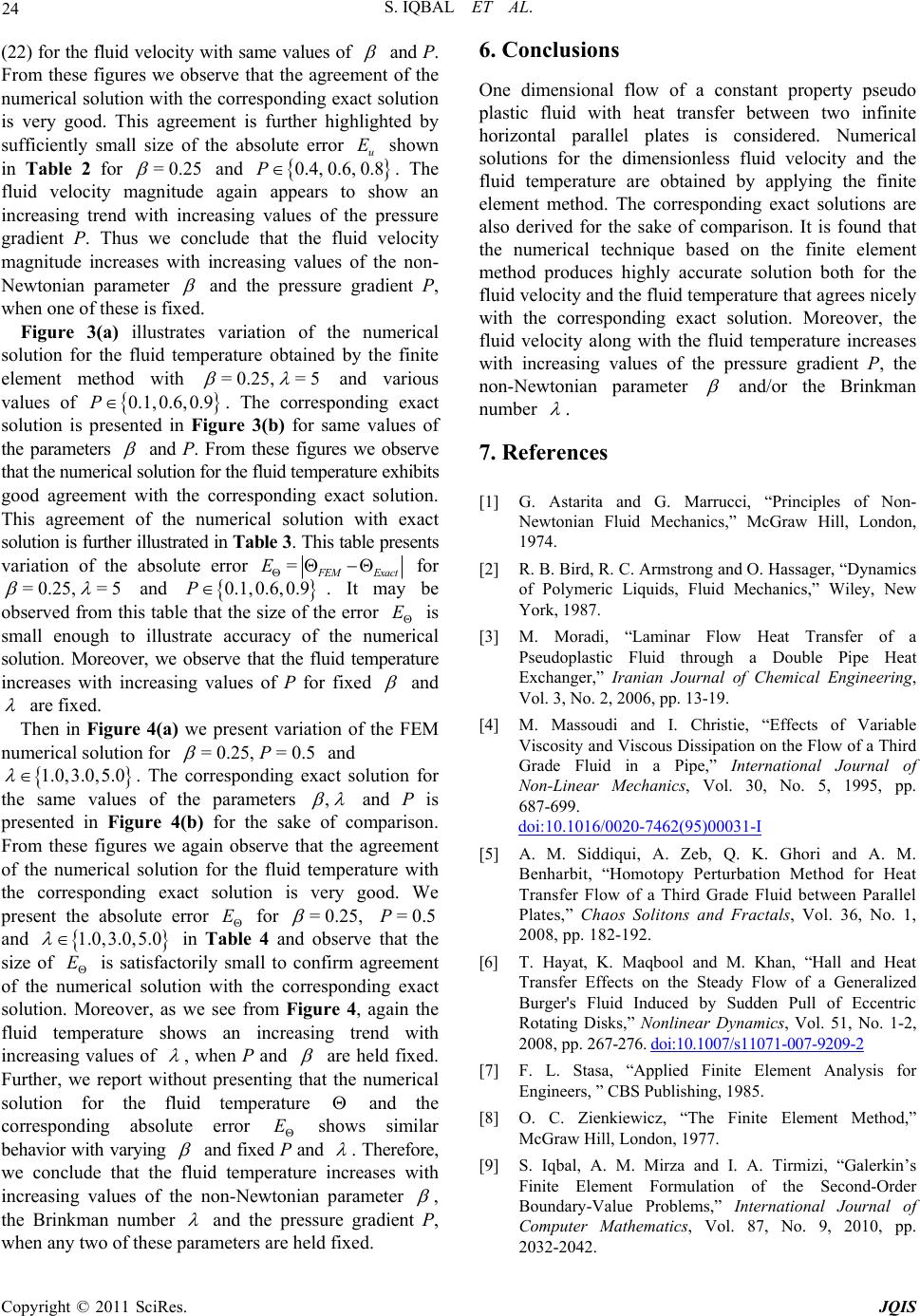
24 S. IQBAL ET AL.
(22) for the fluid velocity with same values of
and P.
From these figures we observe that the agreement of the
numerical solution with the co rresponding exact solution
is very good. This agreement is further highlighted by
sufficiently small size of the absolute error shown
in Table 2 for u
E
=0.25
and . The
fluid velocity magnitude again appears to show an
increasing trend with increasing values of the pressure
gradient P. Thus we conclude that the fluid velocity
magnitude increases with increasing values of the non-
Newtonian parameter
0.80.4, 0.6,P
and the pressure gradient P,
when one of these is fixed.
Figure 3(a) illustrates variation of the numerical
solution for the fluid temperature obtained by the finite
element method with = 0.25,= 5
0.9 and various
values of . The corresponding exact
solution is presented in Figure 3(b) for same values of
the parameters
0.1,0.6 ,P
and P. From these figures we observe
that the numerical sol uti on for the fluid tem pe r ature e x hibits
good agreement with the corresponding exact solution.
This agreement of the numerical solution with exact
solution is further illustrated in Table 3. This table presents
variation of the absolute error =
EM Exact
E for
=0.25, =5
P and . It may be
observed from this table that the size of the error
0.1,0.6 ,0.9
E
is
small enough to illustrate accuracy of the numerical
solution. Moreover, we observe that the fluid temperature
increases with increasing values of P for fixed
and
are fixed.
Then in Figure 4(a) we present variation of the FEM
numerical solution for =0.25, =0.5P
and
1.0,3.0,5.0
6. Conclusions
One dimensional flow of a constant property pseudo
plastic fluid with heat transfer between two infinite
horizontal parallel plates is considered. Numerical
solutions for the dimensionless fluid velocity and the
fluid temperature are obtained by applying the finite
element method. The corresponding exact solutions are
also derived for the sake of comparison. It is found that
the numerical technique based on the finite element
method produces highly accurate solution both for the
fluid velocity and the fluid temperature that agrees nicely
with the corresponding exact solution. Moreover, the
fluid velocity along with the fluid temperature increases
with increasing values of the pressure gradient P, the
non-Newtonian parameter
and/or the Brinkman
number
.
7. References
[1] G. Astarita and G. Marrucci, “Principles of Non-
Newtonian Fluid Mechanics,” McGraw Hill, London,
1974.
[2] R. B. Bird, R. C. Armstrong and O. Hassager, “Dynamics
of Polymeric Liquids, Fluid Mechanics,” Wiley, New
York, 1987.
[3] M. Moradi, “Laminar Flow Heat Transfer of a
Pseudoplastic Fluid through a Double Pipe Heat
Exchanger,” Iranian Journal of Chemical Engineering,
Vol. 3, No. 2, 2006, pp. 13-19.
[4] M. Massoudi and I. Christie, “Effects of Variable
Viscosity and Viscous Dissipa tion on the Flow of a Third
Grade Fluid in a Pipe,” International Journal of
Non-Linear Mechanics, Vol. 30, No. 5, 1995, pp.
687-699.
doi:10.1016/0020-7462(95)00031-I
. The corresponding exact solution for
the same values of the parameters ,
and P is
presented in Figure 4(b) for the sake of comparison.
From these figures we again observe that the agreement
of the numerical solution for the fluid temperature with
the corresponding exact solution is very good. We
present the absolute error E
for = 0.25,
and in Table 4 and observe that the
size of is satisfactorily small to confirm agreement
of the numerical solution with the corresponding exact
solution. Moreover, as we see from Figure 4, again the
fluid temperature shows an increasing trend with
increasing values of
=0.5P
1.0,3.0,
E
[5] A. M. Siddiqui, A. Zeb, Q. K. Ghori and A. M.
Benharbit, “Homotopy Perturbation Method for Heat
Transfer Flow of a Third Grade Fluid between Parallel
Plates,” Chaos Solitons and Fractals, Vol. 36, No. 1,
2008, pp. 182-192.
5.0
, when P and
are held fixed.
Further, we report without presenting that the numerical
solution for the fluid temperature and the
corresponding absolute error shows similar
behavior with varying
E
and fixed P and
. Therefore,
we conclude that the fluid temperature increases with
increasing values of the non-Newtonian parameter
,
the Brinkman number
and the pressure gradient P,
when any two of these parameters are held fixed.
[6] T. Hayat, K. Maqbool and M. Khan, “Hall and Heat
Transfer Effects on the Steady Flow of a Generalized
Burger's Fluid Induced by Sudden Pull of Eccentric
Rotating Disks,” Nonlinear Dynamics, Vol. 51, No. 1-2,
2008, pp. 267-276. doi:10.1007/s11071-007-9209-2
[7] F. L. Stasa, “Applied Finite Element Analysis for
Engineers, ” CBS Publishing, 1985.
[8] O. C. Zienkiewicz, “The Finite Element Method,”
McGraw Hill, London, 1977.
[9] S. Iqbal, A. M. Mirza and I. A. Tirmizi, “Galerkin’s
Finite Element Formulation of the Second-Order
Boundary-Value Problems,” International Journal of
Computer Mathematics, Vol. 87, No. 9, 2010, pp.
2032-2042.
Copyright © 2011 SciRes. JQIS